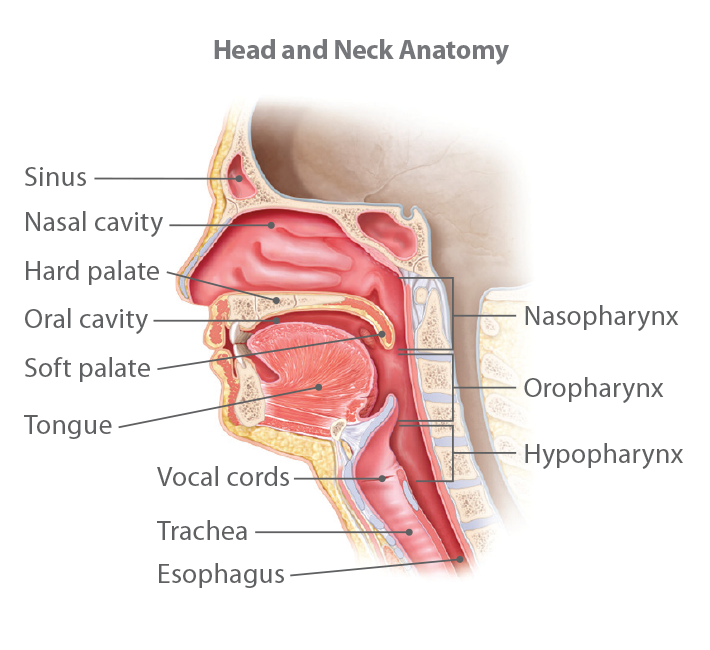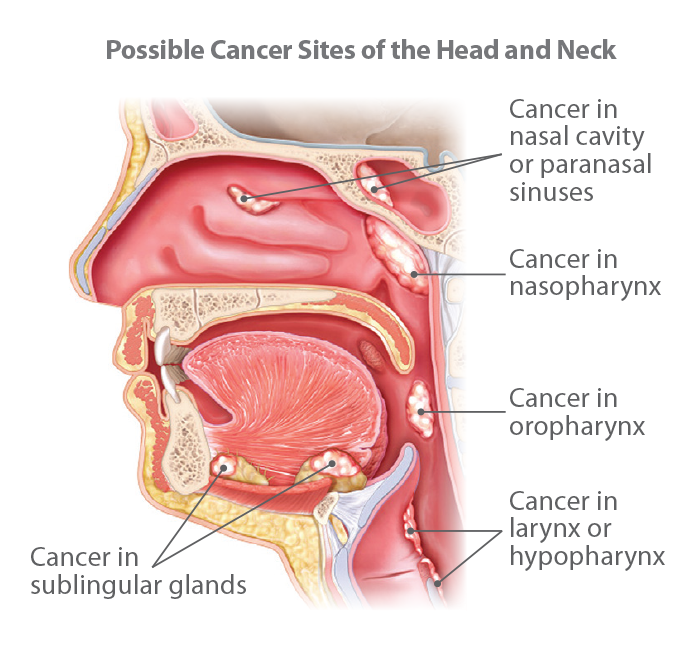Understanding head and neck cancer
Head and neck cancer is a term used to define cancer that develops in the mouth, throat, nose, salivary glands or other areas of the head and neck. More information on cancers of the mouth, oropharynx and oral cavity can be found on cancercenter.com.
Most head and neck cancers are squamous cell carcinomas or cancers that begin in the lining of the mouth, nose and throat. Cancer confined to this layer of cells is called carcinoma in situ. When cancer cells spread into deeper layers of cells, it is called invasive squamous cell carcinoma.
There are five main types of head and neck cancer, each named according to the part of the body where they develop.
Types of head and neck cancer
Laryngeal and hypopharyngeal cancer: The larynx is commonly called the voice box. This tube-shaped organ in the neck is important for breathing, talking, and swallowing. It is located at the top of the windpipe, or trachea. The hypopharynx is also called the gullet. It is the lower part of the throat that surrounds the larynx. Cancer that starts in the larynx is one of the most common types of head and neck cancer.
Nasal cavity and paranasal sinus cancer: The nasal cavity is the space just behind the nose where air passes on its way to the throat. The paranasal sinuses are the air-filled areas that surround the nasal cavity. Nasal cavity and paranasal sinus cancer are uncommon.
Nasopharyngeal cancer: The nasopharynx is the air passageway at the upper part of the throat behind the nose. This disease is uncommon.
Oral and oropharyngeal cancer: The oral cavity includes the mouth and tongue. The oropharynx includes the middle of the throat, from the tonsils to the tip of the voice box. Oral cancer is the ninth most common cancer among men.
Sublingular gland cancer: The sublingular (salivary) gland produces saliva. Saliva is the fluid that is released into the mouth to keep it moist and that contains enzymes that begin breaking down food. Salivary gland cancer is uncommon.
Other types of cancer can also be located in the head and neck region, but the diagnosis and treatment are much different.
TNM system for head and neck cancer
The stage of head and neck cancer is one of the most important factors in evaluating your treatment options. The American Joint Committee on Cancer (AJCC) developed the TNM cancer staging system to evaluate three primary factors when it comes to treating cancer—T, N and M:
Tumor (T): Refers to the size of the primary tumor and to which, if any, tissues in the oral cavity and oropharynx the cancer has spread.
Node (N):Describes the involvement of lymph nodes near the primary tumor. Lymph nodes are small, bean-shaped clusters of immune system cells that are key to fighting infections and are usually one of the first sites in the body to which cancer spreads.
Metastasis (M):Indicates whether the cancer has spread (metastasized) to other areas of the body. With oral cancer, the most common site of metastases is the lungs, followed by the liver and bones.
During the head and neck cancer staging process, your doctor assigns T, N and M values to the disease based on its microscopic appearance. Once the T, N and M scores have been determined, an overall stage is assigned. There is a different staging system for each type of head and neck cancer. Detailed information about these stages can be found on the City of Hope website under each specific cancer type, including:
Larynx and hypopharynx
Oral (including salivary gland)
Sinus
Thyroid

